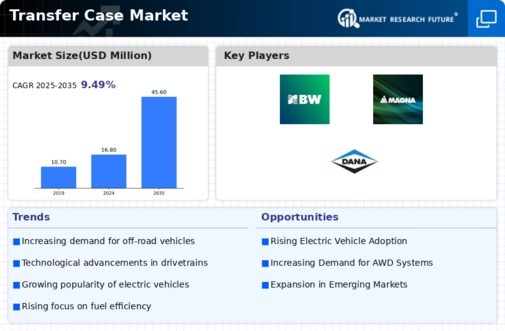Market Analysis
In-depth Analysis of Transfer Case Market Industry Landscape
The Transfer Case Market experiences influences from various factors that collectively determine its dynamics and growth trajectory. A primary driver is the global automotive industry's evolution. As the demand for off-road and all-wheel-drive vehicles continues to rise, so does the demand for transfer cases, integral components that distribute power between the front and rear axles. The increasing popularity of sports utility vehicles (SUVs) and trucks contributes significantly to the growth of the transfer case market.
Technological advancements play a pivotal role in shaping the market landscape. Continuous innovation in transfer case design, materials, and manufacturing processes leads to the development of more efficient, durable, and lightweight systems. The integration of electronic components, such as sensors and actuators, enhances the performance and controllability of transfer cases, meeting the demands of modern automotive applications. Manufacturers need to stay abreast of these technological developments to remain competitive and address the evolving needs of the automotive industry.
Off-road enthusiasts and recreational activities contribute to the transfer case market's growth. The demand for high-performance transfer cases with advanced features is driven by the off-road and recreational vehicle market. As consumers seek vehicles capable of handling diverse terrains and challenging conditions, the importance of robust and adaptable transfer cases becomes evident. Manufacturers catering to the off-road segment must align their product offerings with the specific requirements of this niche market.
Regulatory standards and emissions requirements impact the transfer case market dynamics. As governments worldwide impose stricter emissions regulations, automotive manufacturers are compelled to design more fuel-efficient vehicles. Transfer cases, by optimizing power distribution and reducing drivetrain losses, play a role in enhancing overall vehicle efficiency. Compliance with regulatory standards and emissions targets is a crucial consideration for transfer case manufacturers to ensure market relevance.
Economic factors, including consumer purchasing power and overall automotive industry performance, influence the transfer case market. Economic downturns may lead to reduced consumer spending on vehicles, affecting the demand for transfer cases. Conversely, periods of economic growth and stability witness increased sales of vehicles, positively impacting the market. The cyclical nature of the automotive industry necessitates market players to adapt their strategies to changing economic conditions.
Globalization and supply chain dynamics contribute to the market's complexity. Transfer case manufacturers must navigate the challenges posed by global supply chains, including sourcing raw materials, components, and managing logistics. Trade policies, geopolitical tensions, and disruptions in the supply chain can impact the availability and pricing of key components used in manufacturing transfer cases.
Consumer preferences and advancements in vehicle design influence the transfer case market. As consumers increasingly seek vehicles with advanced features, comfort, and performance, transfer case manufacturers need to adapt to these changing preferences. The integration of transfer cases in hybrid and electric vehicles, which are gaining popularity, adds another dimension to the market dynamics. Manufacturers must innovate to meet the evolving demands of consumers and stay competitive in an ever-changing automotive landscape.
Competition and market consolidation are essential factors shaping the transfer case market. Mergers, acquisitions, and partnerships among key players influence market dynamics, impacting pricing, innovation, and market share. Transfer case manufacturers need to strategically position themselves in the competitive landscape to capitalize on opportunities and address challenges posed by industry consolidation.
In conclusion, the Transfer Case Market is shaped by a combination of factors, including the automotive industry's evolution, technological advancements, off-road and recreational vehicle demand, regulatory standards, economic trends, globalization, consumer preferences, and competitive dynamics. Navigating these diverse influences requires transfer case manufacturers to stay adaptive, innovative, and strategic in their approach to meet the evolving needs of the automotive industry and maintain a competitive edge in the transfer case market.







Leave a Comment